Calcium and iron regulate swarming and type III secretion in Vibrio parahaemolyticus
- PMID: 20851895
- PMCID: PMC2976450
- DOI: 10.1128/JB.00654-10
Calcium and iron regulate swarming and type III secretion in Vibrio parahaemolyticus
Abstract
Here, we probe the response to calcium during growth on a surface and show that calcium influences the transcriptome and stimulates motility and virulence of Vibrio parahaemolyticus. Swarming (but not swimming) gene expression and motility were enhanced by calcium. Calcium also elevated transcription of one of the organism's two type III secretion systems (T3SS1 but not T3SS2) and heightened cytotoxicity toward host cells in coculture. Calcium stimulation of T3SS gene expression has not been reported before, although low calcium is an inducing signal for the T3SS of many organisms. EGTA was also found to increase T3SS1 gene expression and virulence; however, this was demonstrated to be the consequence of iron rather than calcium chelation. Ectopic expression of exsA, encoding the T3SS1 AraC-type regulator, was used to define the extent of the T3SS1 regulon and verify its coincident induction by calcium and EGTA. To begin to understand the regulatory mechanisms modulating the calcium response, a calcium-repressed, LysR-type transcription factor named CalR was identified and shown to repress swarming and T3SS1 gene expression. Swarming and T3SS1 gene expression were also demonstrated to be linked by LafK, a σ(54)-dependent regulator of swarming, and additionally connected by a negative-feedback loop on the swarming regulon propagated by ExsA. Thus, calcium and iron, two ions pertinent for a marine organism and pathogen, play a signaling role with global consequences on the regulation of gene sets that are relevant for surface colonization and infection.
Figures
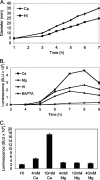

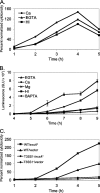
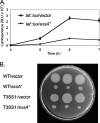

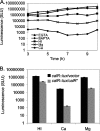


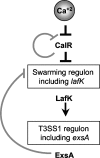
Similar articles
-
Structural and regulatory mutations in Vibrio parahaemolyticus type III secretion systems display variable effects on virulence.FEMS Microbiol Lett. 2014 Dec;361(2):107-14. doi: 10.1111/1574-6968.12619. Epub 2014 Oct 31. FEMS Microbiol Lett. 2014. PMID: 25288215 Free PMC article.
-
Type III secretion system 1 genes in Vibrio parahaemolyticus are positively regulated by ExsA and negatively regulated by ExsD.Mol Microbiol. 2008 Aug;69(3):747-64. doi: 10.1111/j.1365-2958.2008.06326.x. Epub 2008 Jun 28. Mol Microbiol. 2008. PMID: 18554322 Free PMC article.
-
The Transcriptional Regulator HlyU Positively Regulates Expression of exsA, Leading to Type III Secretion System 1 Activation in Vibrio parahaemolyticus.J Bacteriol. 2018 Jul 10;200(15):e00653-17. doi: 10.1128/JB.00653-17. Print 2018 Aug 1. J Bacteriol. 2018. PMID: 29440251 Free PMC article.
-
[Type III secretion system of Vibrio parahaemolyticus--a review].Wei Sheng Wu Xue Bao. 2009 Jul;49(7):848-52. Wei Sheng Wu Xue Bao. 2009. PMID: 19873746 Review. Chinese.
-
The role of type III secretion system 2 in Vibrio parahaemolyticus pathogenicity.J Microbiol. 2012 Oct;50(5):719-25. doi: 10.1007/s12275-012-2550-2. Epub 2012 Nov 4. J Microbiol. 2012. PMID: 23124738 Review.
Cited by
-
Calcium transcriptionally regulates movement, recombination and other functions of Xylella fastidiosa under constant flow inside microfluidic chambers.Microb Biotechnol. 2020 Mar;13(2):548-561. doi: 10.1111/1751-7915.13512. Epub 2019 Nov 14. Microb Biotechnol. 2020. PMID: 31729188 Free PMC article.
-
Vibrio parahaemolyticus cqsA controls production of quorum sensing signal molecule 3-hydroxyundecan-4-one and regulates colony morphology.J Microbiol. 2019 Dec;57(12):1105-1114. doi: 10.1007/s12275-019-9379-x. Epub 2019 Nov 4. J Microbiol. 2019. PMID: 31686391
-
Stenotrophomonas maltophilia virulence and specific variations in trace elements during acute lung infection: implications in cystic fibrosis.PLoS One. 2014 Feb 28;9(2):e88769. doi: 10.1371/journal.pone.0088769. eCollection 2014. PLoS One. 2014. PMID: 24586389 Free PMC article.
-
Effects of Calcium and Signal Sensing Systems on Azorhizobium caulinodans Biofilm Formation and Host Colonization.Front Microbiol. 2020 Sep 16;11:563367. doi: 10.3389/fmicb.2020.563367. eCollection 2020. Front Microbiol. 2020. PMID: 33072026 Free PMC article.
-
ZrgA contributes to zinc acquisition in Vibrio parahaemolyticus.Virulence. 2023 Dec;14(1):2156196. doi: 10.1080/21505594.2022.2156196. Virulence. 2023. PMID: 36482737 Free PMC article.
References
-
- Butler, A. 2005. Marine microbial iron mobilization: new marine siderophores, abstr. U893. Abstr. Papers Am. Chem. Soc., vol. 229.
Publication types
MeSH terms
Substances
Associated data
- Actions
Grants and funding
LinkOut - more resources
Full Text Sources
Medical
Molecular Biology Databases
Research Materials
Miscellaneous

